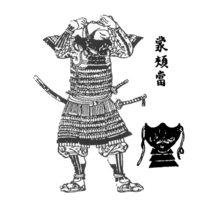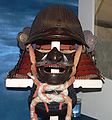- Menpō
-
A menpō (面頬) (or menbō, mempō, menko, sako-bo)[1] is one of several types of facial armour (mengu) worn by the samurai class in feudal Japan. Other types of mengu include the somen, hanpo or hanpo, and happuri.
Contents
Description
The menpō was facial armor (men yoroi[2] or mengu) which covered the face from the nose down to the chin and also provided a way to secure the top heavy samurai helmet or kabuto. The chin cord (Shinobi-no-o) of the kabuto would be tied under the chin of the menpō.[2] There were also small hooks (ori-kugi) or posts (odome) on the menpō to help secure the kabuto's chin cord. Menpō may be constructed from iron or leather (nerigawa) or a combination of both. They may have a lacquered or rusted type of finish and can include a variety of facial details, such as moustaches, fierce teeth and colors. [3]Most menpō had a small hole (ase nagashi no ana) underneath the chin for drainage.
The menpō is similar to masks worn by armored cavalry and infantry in ancient Chinese armies from the Han Dynasty to the Song Dynasty.
Gallery
-
A kabuto with mempo
References
- ^ A Glossary of the Construction, Decoration and Use of Arms and Armor: In All Countries and in All Times, George Cameron Stone, Courier Dover Publications, 1999 p.445
- ^ a b Samurai 1550-1600, Anthony J. Bryant, Angus McBride, Osprey Publishing, 1994 p.28
- ^ The Watanabe Art Museum Samurai Armour Collection (Kabuto & Mengu, Volume I) Trevor Absolon (Author), Brian Snoody (Illustrator), Barry Till (Preface), Anthony J. Bryant (Editor), Trevor Absolon & Dave thatcher (Photographer), Ian Bottomley (Introduction), Ian Bottomley & Anthony J. Bryant (Foreword) Publisher(Toraba), 2011
External links

This medieval armour-related article is a stub. You can help Wikipedia by expanding it.





